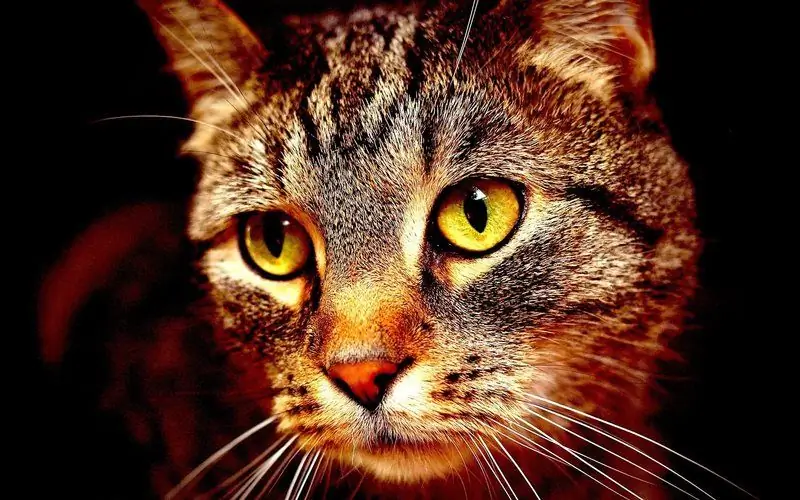
Table of contents:
- Flea dermatitis in cats: a major consequence of small parasites
- What fleas look like in cats
- What causes flea dermatitis in cats?
- The main manifestations of flea dermatitis in cats
- Flea dermatitis diagnostics
- Treatment for flea dermatitis in cats
- How to get rid of and prevent fleas from a cat
- Danger of flea dermatitis in cats to humans
- Author Bailey Albertson [email protected].
- Public 2024-01-17 22:26.
- Last modified 2025-06-01 07:32.
Flea dermatitis in cats: a major consequence of small parasites

Veterinarians estimate that fleas cause up to 80% of allergic dermatitis in pets. Flea dermatitis is distressing to the cat and requires immediate intervention from the owner.
Content
-
1 What do fleas look like in cats
1.1 Ways of infestation by fleas
-
2 Causes of Flea Dermatitis in Cats
2.1 Video: flea dermatitis
-
3 Main manifestations of flea dermatitis in cats
3.1 Photo gallery: manifestations of flea dermatitis in cats
- 4 Diagnosis of flea dermatitis
-
5 Treatment for flea dermatitis in cats
- 5.1 Photo gallery: drugs for the treatment of flea dermatitis
- 5.2 Table: products used for external treatment of fleas
- 5.3 Means used internally
- 5.4 Traditional medicines
- 5.5 Photo gallery: traditional medicine for the treatment of flea dermatitis:
- 5.6 Features in the treatment of pregnant cats and kittens
- 6 How to get rid of fleas and prevent their appearance
-
7 Dangers of flea dermatitis in cats to humans
7.1 Video: how to get rid of fleas in a pet and in an apartment
What fleas look like in cats
Fleas are wingless brown insects with 3 pairs of paws, the last of which is better developed than the rest and is used to push off the surface when jumping, the length of which can reach 1.5 meters. Their body is laterally flattened, its length is 2-2.5 mm.

The flea has a laterally flattened body and three pairs of paws; no wings
The flea is protected from external influences by the chitinous membrane, on which there are multiple thorns and outgrowths, which help it to stay on the surface of the skin and wool. The oral apparatus of the parasite is a piercing-sucking type.
The flea lives for about 2 years, while actively multiplying. Flea eggs lay where they have to, the worm-like larvae released from the eggs feed on dust, debris, and various contaminants. The larvae turn into pupae, which under unfavorable external conditions can remain viable in the external environment for up to 1 year. The entire development cycle of a flea, under favorable conditions, takes only 2-3 weeks.
Fleas are highly mobile and have a tendency to change hosts. It is extremely important that most fleas live in the room where the cat is kept, while the number of parasites on the cat itself does not exceed 5-10% of the available one.
Fleas are carriers of diseases:
- hemobartonellosis - feline infectious anemia;
- tularemia - a natural focal infectious disease;
-
helminthic invasions:
- dipylidiosis - parasitizing cucumber tapeworm;
- dipetalonematosis - parasitizing small roundworms - microfilariae. The disease occurs in Africa, South America, and southern Asia.
Flea Infection Routes
Flea infestation occurs when:
- direct contact with infected relatives;
- through litter, toys, care items infected with fleas, their eggs and larvae;
- fleas can live in an apartment, periodically attacking a cat;
- A mother cat with fleas infects kittens with them immediately after their birth.

If a mother cat has fleas, all her kittens are infected
What causes flea dermatitis in cats?
Flea dermatitis is an inflammatory skin disease of allergic origin. It is based on the formation of hypersensitivity to flea bites, the saliva of which is a complex allergen. Distinguish:
-
Immediate hypersensitivity reactions - occur when an allergen re-enters the body, to which an antibody titer has already been developed. The meeting of an allergen and an antibody occurs on the membrane of mast cells and causes the release of a large amount of biologically active substances (histamine, bradykinin, serotonin, heparin, reactive oxygen species).
This type of reaction with flea dermatitis is manifested by the occurrence of:
- redness of the skin;
- itchy skin;
- urticaria (the appearance of skin infiltrates, accompanied by itching and redness of the skin). In some cases, these signs appear immediately after the very first flea bite, while we are talking about atopy - an altered type of response of the immune system that is inherited.
- Delayed type hypersensitivity reactions - the leading role belongs to the activated cells of the immune system, which migrate to the allergen, form and maintain a focus of chronic skin inflammation. In most cases, the development of clinical manifestations of this type of reaction requires 3-6 years of regular contact with fleas.
Fortunately, flea dermatitis does not affect all cats that have been bitten by fleas, since flea bites do not cause allergic changes in the immune system in all cats. Most often, with flea dermatitis, cats develop delayed-type hypersensitivity reactions or a mixed type of reaction. For the disease of flea dermatitis, as well as its exacerbations, seasonality is characteristic. When fleas live indoors, there is no seasonality of the disease in cats.
Video: flea dermatitis
The main manifestations of flea dermatitis in cats
The most common manifestations of flea dermatitis in cats are:
- miliary dermatitis - redness and multiple vesicles (vesicles) appear on the skin, which, opening, form small erosions. After the erosion dries up, numerous crusts appear. With a prolonged course of the disease, the affected areas acquire a dark color - acanthosis black develops. The coat is thinning and falling out. The disease is accompanied by unbearable itching of the skin; during the calculations, infection with the secondary microbial flora occurs;
- the formation of foci of baldness in the absence of inflammatory manifestations;
-
development of a complex of eosinophilic granulomas - accumulations in the lesions of eosinophils and lymphocytes take part in the development of all its forms. Manifestations:
-
eosinophilic granuloma - looks like:
- whitish nodules or bumps on the oral mucosa;
- linear intradermal thickening on the body.
- eosinophilic plaque - an area of an eroded surface with clear edges, shiny, causing severe itching;
- indolent ulcer - an ulcer or erosion on the lips, with clear edges, infiltrated base, painless, usually gray-yellow in color. Simultaneous damage to the skin and mucous membrane is typical. Deforms the lip at large sizes.
-
-
the presence of persistent itching, the cat scratches the skin with its paws and pulls out pieces of hair with its teeth, lumps of swallowed hair are found in the stool, which can cause:
- nausea;
- vomiting;
- constipation.
-
development of secondary bacterial or fungal dermatitis, with the addition of pyogenic flora, pyoderma occurs, which manifests itself:
- deterioration of the general condition of the cat;
- fever;
- increased swelling and redness of the skin;
- the appearance of purulent discharge;
- an increase and soreness of regional lymph nodes.
-
violation of general well-being:
- irritability;
- insomnia;
- unwillingness to play;
- decreased appetite.
Photo gallery: manifestations of flea dermatitis in cats
-

a large area of hair loss with pigmentation of the skin on the back in a cat - baldness is a common sign of flea dermatitis
-

eosinophilic granuloma - eosinophilic granulomas appear as intradermal thickenings in the form of a line
-

eosinophilic plaques - eosinophilic plaques can coalesce to form continuous eroded surfaces
-

dermatitis on the cat's face - acute dermatitis caused by an allergy to flea bites
-

miliary dermatitis - miliary dermatitis is represented by small erosions and crusts on the skin
Flea dermatitis diagnostics
The diagnosis is made based on:
- detection of typical skin manifestations with signs of flea infestation (presence of fleas or their excrement on the cat's skin);
- examining scrapings from the skin of a cat;
- histological examination of a skin sample - in some cases, to clarify the nature of the disease;
- a general blood test - an increase in the content of eosinophils is characteristic, with a complication of allergic dermatitis by a secondary microbial flora, leukocytosis will appear; when infected from fleas with hemobartonellosis or helminths, hemoglobin will decrease;
- allergic skin tests - are necessary in cases where the signs of flea parasitism are not visually detected in the cat. Fleas can bite a cat from time to time, without parasitizing on it and living in the external environment;
- the presence of positive dynamics during the course of the disease after the use of drugs that destroy fleas.
The owner of the cat can suspect the presence of flea dermatitis on its own, but a veterinarian examination is necessary, since there are diseases that have similar symptoms:
-
tick lesions:
- sarcoptic mange;
- notoedrosis;
- demodicosis.
- dermatophytosis - fungal skin lesions;
- bacterial dermatitis, such as pyoderma;
- food allergy;
- drug allergy;
- autoimmune diseases.

When infested with fleas, dark flea excrement is detected in the cat's fur
Treatment for flea dermatitis in cats
For the treatment of flea dermatitis, the following are used:
-
Corticosteroids - in order to suppress the reaction of allergic inflammation, are effective in 90% of cases of systemic use:
- Prednisolone;
- Dexamethasone;
- Hydrocortisone.
- Cytostatic Cyclosporin - used when corticosteroids are ineffective, suppresses the immune response.
-
Antihistamines - effective in 30% of cases of use for immediate sensitization reactions, as well as for mixed reactions:
- Tavegil;
- Pipolfen.
-
Antibacterial drugs - with the addition of secondary bacterial flora:
- Sinulox;
- Tsiprovet.
- Antifungal drugs - with the addition of a secondary fungal flora, for example, Itraconazole.
-
Flea control products:
- Stronghold;
- Frontline;
- Leopard.
-
Repellents - scare away fleas, preventing their attack:
- Advantage - both effectively destroys and scares off parasites, this is a rare combination of properties;
- Celandine, drops - have a repellent effect, in the presence of flea infestation, they are ineffective.
-
Calcium supplements - reduce itching and swelling, reducing vascular permeability:
- calcium chloride;
- calcium gluconate.
- Sodium thiosulfate - used as a course of treatment to reduce individual sensitivity to flea bites.
-
Vitamins containing polyunsaturated fatty acids and biotin - to improve skin condition:
- Feliderm;
- Kanina Kanivita.
-
Healing shampoos - reduce the number of fleas, as well as improve the condition of the skin and coat:
- Rolf Club;
- Phytoelite.
-
Topical Antimicrobials - Used to treat skin lesions:
- Levomekol ointment;
- 1-2% solution of aqueous chlorhexidine;
- 3% hydrogen peroxide solution.
Photo gallery: drugs for the treatment of flea dermatitis
-

Prednisolone - Prednisolone quickly relieves itching and reduces inflammation in flea dermatitis
-

Tsiprovet - Tsiprovet is prescribed for a short course of 5 days in the presence of bacterial complications
-

Tavegil - Tavegil suppresses the release of histamine from mast cells in immediate allergic reactions
-

Advantage - The uniqueness of Advantage lies in the combination of insecticidal and repellent effects
-

Stronghold - Stronghold effectively destroys fleas at all stages of their development
Table: means used for external treatment of fleas
| A drug | Structure | Operating principle | Price, rub |
| Stronghold, drops on the withers | Selamectin | Destroys eggs, larvae and adult forms of external parasites, as well as round worms. It is applied once a month. It is possible during pregnancy and feeding kittens. Not allowed for kittens under 6 weeks of age | 386 |
| Frontline Spray | Fipronil | Destroys external parasites and ixodid ticks. Protects against fleas for up to 40 days. Do not bathe 2 days before using the spray, as well as 2 days after. Suitable for pregnant and lactating cats, as well as kittens from 2 days of age | 881 for 100 ml |
| Leopard, drops on the withers |
|
Destroys external parasites and ixodid ticks. Protects against fleas for up to 1-2 months. Do not use during pregnancy, lactation, kittens up to 8 weeks | 176 |
| Green Fort | Citronella essential oil | It repels fleas and other external parasites. Can be used in pregnant and lactating cats, in kittens from 4 weeks of age. Highly safe product | 375 |
Means used internally
Oral flea control agents:
-
Comfortis tablets - the active ingredient is spinosad, which causes paralysis and death of fleas. The action begins within half an hour after taking the pill and lasts for 1 month. Does not apply when:
- pregnancy;
- lactation;
- kittens under 14 weeks of age;
- epilepsy;
- individual hypersensitivity to the components of the product.
- Suspension Program - the active substance lufenuron, which disrupts the synthesis of chitin and has a detrimental effect on eggs and larvae of fleas. Does not kill adult insects. It is applied once a month. Combines with adult flea killers.
Traditional medicine
With flea dermatitis, the use of folk remedies is possible, but it is better to do this in combination with veterinary drugs to destroy skin parasites, as well as taking medications prescribed by a veterinarian. Folk remedies will improve the condition of the skin and coat, help get rid of some of the parasites, but it will not work to cure flea dermatitis using only folk remedies.
As folk methods, bathing a pet in herbal infusions is used:
-
capable of destroying a small number of parasites:
- wormwood;
- tansy.
-
capable of disinfecting skin lesions:
- calendula;
- celandine;
- chamomile.
Bathing infusions are prepared:
- Take 100 g of dry herb.
- Add 2 liters of boiling water.
- Insist 30 minutes in a water bath.
- Insist within 1 hour after removing from the water bath.
- Strain the infusion.
- Add water to the required volume for bathing.
To scare off parasites, you can use a bag of dried wormwood or tansy grass, tied to a cat's collar.
Photo gallery: traditional medicine for the treatment of flea dermatitis:
-

Tansy - Infusion of tansy can be used to wash a cat to reduce the number of parasites
-

Wormwood - dry wormwood in a bag, attached to a cat's collar, is able to scare away fleas
-

Calendula - infusion of calendula has a disinfecting effect on skin lesions, and also reduces inflammation
Features in the treatment of pregnant cats and kittens
The development of flea dermatitis in pregnant cats is very dangerous, since the severe disease requires the use of corticosteroids and antibiotics, which are contraindicated in pregnancy. In small kittens, flea dermatitis occurs extremely rarely until the age of 6 months, is represented by reactions of an immediate type and usually indicates an existing atopy, the extreme manifestation of which can be anaphylactic shock, which carries a direct threat to the life of the kitten. It is important to prevent flea attacks on pregnant cats and small kittens; if there is a flea infestation, it is necessary to treat the mother-cat and babies with Frontline-spray, which is allowed for use in pregnant and lactating cats, as well as in kittens from 2 days of age.
How to get rid of and prevent fleas from a cat
It is necessary to act on fleas in a complex manner, since fleas at different stages of development and in large numbers are kept in the room where the infected cat lives:
- all pets with wool are treated simultaneously from external parasites;
- in the future, the protection of animals is achieved by the regular prophylactic use of insecticidal agents, as well as repellents in any form convenient for the owner for all pets;
- regular repeated wet cleaning of the floor and horizontal surfaces using Neostomosan or Ecocid solutions;
- upholstered furniture, carpets, car interiors, cat beds are regularly vacuumed, reliably getting rid of the contents of the vacuum cleaner (it is better to burn), and you can also use a steam generator;
- to prevent contacts of pets with strangers;
- wash your hands thoroughly after contact with other people's pets to prevent the transfer of parasites to your cat.

Regular treatment of fleas with veterinary insecticides is used both for the treatment of flea dermatitis and for its prevention
Danger of flea dermatitis in cats to humans
Flea dermatitis in cats is not dangerous to humans, unlike fleas themselves, which can be carriers of pathogens that are dangerous to humans:
- plague;
- tularemia;
- flea typhus;
- pasteurellosis;
- dipylidiosis;
- nonspecific bacterial and fungal flora.
Video: how to get rid of fleas from a pet and in an apartment
Flea dermatitis develops as a result of an allergic alteration of the cat's immune system caused by flea bites, the saliva of which is a strong allergen. Only a veterinarian can verify the diagnosis and prescribe appropriate treatment, since there are skin diseases with similar manifestations. It is much easier to prevent flea parasitism on a pet by regular use of veterinary insecticidal agents than to treat developed flea dermatitis.
Recommended:
Ear Mite (otodectosis) In Cats And Cats: Photos, Symptoms Of The Disease And Its Treatment At Home (including A Kitten), Reviews

Description of the causative agent of otodectosis, how the infection occurs, the symptoms of the disease. How to diagnose and treat otodectosis. Preventive measures
Lice Beetles In Cats: Photos Of Lice And Symptoms Of Their Lesion On The Skin, Diagnosis, Treatment And Prevention At Home

The causative agent of feline trichodectosis looks like the main symptoms. Complications of trichodectosis. How to detect and cure. Prevention of trichodectosis
Cystitis In Cats And Cats: Symptoms (blood In Urine And Others) And Treatment At Home, Medications (pills And Others), Veterinarian Advice

What causes cystitis, its symptoms, course forms, diagnosis, treatment. Caring for a sick cat, prevention of cystitis
Stomatitis In Cats (gangrenous And Others): Symptoms And Treatment At Home, Effective Drugs, Prevention

What is stomatitis in cats, its causes. Course types, symptoms. When to see your veterinarian. How to heal at home. Disease prevention. Recommendations
Enteritis In Cats: Symptoms, Diagnosis And Treatment (including At Home), Prevention, Recommendations Of Veterinarians

What is viral enteritis. Infection routes. Types of the disease. When to see your veterinarian. How to treat at home. Prevention. Doctor's advice
